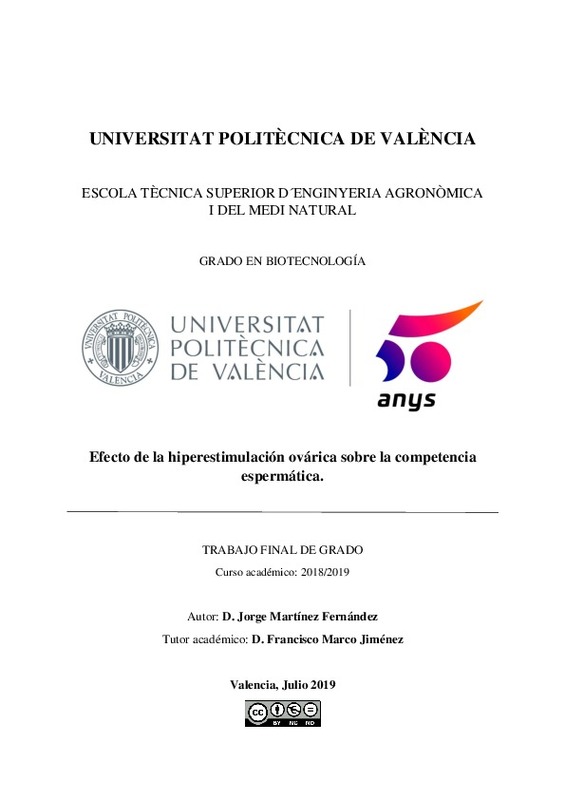|
Resumen:
|
[ES] La hiperestimulación ovárica es un tratamiento que se utiliza rutinariamente para optimizar el empleo de las técnicas de reproducción asistida, y consiste en someter a las hembras a una sobre exposición a hormonas ...[+]
[ES] La hiperestimulación ovárica es un tratamiento que se utiliza rutinariamente para optimizar el empleo de las técnicas de reproducción asistida, y consiste en someter a las hembras a una sobre exposición a hormonas gonadotropinas exógenas con el objetivo de incrementar su ratio de ovulación respecto al que ocurre en condiciones fisiológicas. Sin embargo, esta práctica no se encuentra exenta de controversia ya que su aplicación genera un ambiente endocrino uterino-oviductal alterado, que parece inducir modificaciones en los órganos reproductores femeninos que podrían generar alteraciones en el normal desarrollo de la ovulación, el transporte y selección de los espermatozoides que producirán la fecundación y el desarrollo embrionario temprano. Por ello, los objetivos de este trabajo son evaluar el efecto del tratamiento de hiperestimulación ovárica mediante la hormona recombinante corifolitropina alfa sobre la competencia espermática y la paternidad de la descendencia obtenida tras la inseminación artificial con una mezcla heterospérmica y determinar el efecto que las modificaciones inducidas por este tipo de tratamientos producen sobre la calidad embrionaria mediante el estudio de la expresión génica de los genes de pluripotencia OCT4, SOX2 y NANOG en embriones preimplantacionales. Los resultados obtenidos muestran que el ratio de recuperación de embriones preimplantacionales fue significativamente superior en las hembras sometidas al tratamiento de hiperestimulación, y que los genes SOX2 y NANOG estaban significativamente sobre expresados en estos embriones en comparación con los controles. Además, también se observó que este tipo de tratamientos modifica significativamente el patrón de paternidad observado tras la realización de una inseminación heterospérmica. Por lo tanto, se puede concluir que los tratamientos de hiperestimulación ovárica con la hormona recombinante corifolitropina alfa estimulan la respuesta ovárica de la hembra produciendo un incremento en la masa ovárica, la tasa de ovulación y la tasa de recuperación en embriones de seis días. Sin embargo, este tipo de tratamientos parece afectar a la calidad de los embriones producidos, ya que estos exhiben un patrón diferencial de expresión de mARN de los genes SOX2 y NANOG. Además, estos tratamientos afectan a la competencia espermática y alteran la paternidad de la descendencia obtenida tras la inseminación artificial con una mezcla heterospérmica.
[-]
[EN] Ovarian hyperstimulation is a treatment which is routinely used to optimize the use of assisted reproduction techniques, and consists on subjecting the females to an overexposure to exogenous gonadotropin hormones in ...[+]
[EN] Ovarian hyperstimulation is a treatment which is routinely used to optimize the use of assisted reproduction techniques, and consists on subjecting the females to an overexposure to exogenous gonadotropin hormones in order to increase their ovulation rate compared to the one they exhibit under physiological conditions. However, this practice is not exempt from controversy, since its application generates an altered uterine-oviductal endocrine environment which seems to induce modifications in the female reproductive organs that could generate alterations in the normal development of ovulation, the transport and selection of the fertilizing spermatozoa and the early embryonic development. Therefore, the objectives of this study are to evaluate the effect of the ovarian hyperstimulation treatment with recombinant hormone coriofollitropin alfa on sperm competition and offspring paternity after an artificial insemination using a heterospermic mixture, and to determine the effect that the induced modifications by this type of treatments produce on the embryonic quality through the study of the gene expression of the OCT4, SOX2 and NANOG pluripotency genes in preimplantational embryos. The results obtained show that the recovery rate of preimplantational embryos was significantly higher in the females subjected to the hyperstimulation treatment, and that SOX2 and NANOG genes were significantly overexpressed in these embryos when compared to the controls. In addition, it was also observed that this type of treatment significantly modifies the observed paternity pattern after a heterospermic insemination. Therefore, it can be concluded that ovarian hyperstimulation treatments with recombinant hormone coriofollitropin alfa effectively stimulate the ovarian response of the female, producing an increase in the total ovarian mass, the ovulation rate and the six-day embryo recovery rate. However, these treatments seem to affect the quality of the produced embryos, since they exhibit a differential pattern on the mRNA expression of SOX2 and NANOG genes. In addition, these treatments affect sperm competition and alter the paternity of the obtained offspring after an artificial insemination using a heterospermic mixture.
[-]
|







